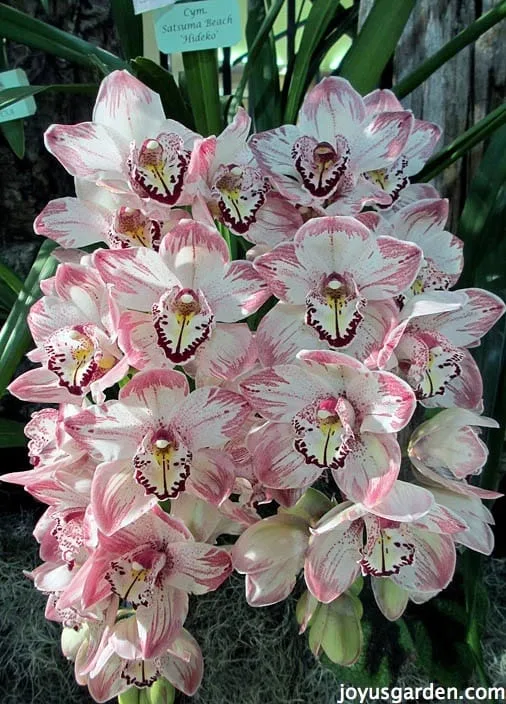Cymbidium Orchid Care
Beautiful, wonderful Cymbidium Orchids! I used to live in Santa Barbara, CA, which has our country’s greatest concentration of orchid growers. The cymbidium season here is October through May, so I always have a vase full of beautiful blooms in my house during these months. They last for weeks. The cut flowers and plants are even sold at our farmers’ market.

These easy-care orchids thrive outdoors in our coastal climate with warm days and cool nights. I grow a few of my own, and they repeat bloom every year.
I will share with you what they like, how I take care of mine, and some tidbits I’ve learned from the growers.
Cymbidium Orchid Characteristics
Light
Cymbidium orchids like bright light but not hot, burning sun. Be sure to protect them from the midday sun if that’s an issue where you live. In the winter, however, they can take more sun.
Temperature

As I said above, warm in the day and cool at night is best. This is why they aren’t the ideal houseplant orchid-like the popular Phalaenopsis. They don’t like the low light of interiors nor the dry heat of our homes.
If the evenings are too warm, you won’t get a good bloom set. They need those cooler temps to bring on those flower spikes. The lowest they can go is around 30 degrees but not for a prolonged period. Consistent temps below freezing will hinder the bloom too.
Watering
They don’t like to dry out completely. Watering once a week is a good general rule, but that will vary depending on what’s going on climate-wise. These orchids do appreciate a little more water during their growing season. Be sure to use room-temperature water.
Of course, they love rainwater. If you see brown tips on your orchid leaves, it could be because your water has too much salt. You should use distilled water instead of tap water.
Humidity

Outdoor humidity is fine except for hot, dry climates. They love the Central/Southern California coastal climates.
Fertilizer
The growers use a high-nitrogen fertilizer at one time of year and a low-nitrogen flower booster at another time of year. I was talking to one of the growers about this, and she said the timing must be spot on. She recommends using a balanced fertilizer, like 20-20-20 at reduced strength, year-round at monthly intervals. Once a month is fine – no more.
Repotting
The best time to do this is right after your Cymbidium Orchid has bloomed. As a rule, you don’t need to do it more than every 2-3 years and they bloom best when tight in their pots.
They like a slightly acidic mix so it’s best to use a good one that is specially formulated for cymbidiums. This is one orchid that grows on trees or in the ground so the mix will differ from other orchids.
Good to Things to Know About Cymbidium Orchids:
Cymbidiums bloom best when pot-bound, so don’t rush to repot them unless they need it. Only go up one pot size and be sure that pot is clean as these orchids are susceptible to bacterial infection. Be sure not to bury the bulbs (they’re pseudobulbs), and don’t cut off any roots sticking out of the top.
Ensure the pot has at least one drain hole, as they hate sitting in water. Spread and loosen the roots a bit before repotting. Water well and make sure it thoroughly drains out.

Remember, Cymbidium Orchids like bright light and cool evening temps to bloom. After yours has flowered, cut those stems all the way down to the base of the plant to get it to bloom again next year.
They’re available in such a wide array of colors and patterns now that I want them all. I use restraint and visit the orchid greenhouses during the season to get my cymbidium fix. Orchid mania on the Central Coast of California!
This post may contain affiliate links, you can read our policies here.






Hi, thanks for all the great info. I think I know now what’s causing the ugly brown/black leaf tips on my plant. I plan to switch to bottled water as our culinary water is pretty hard and I continue to have this issue despite using a water filter pitcher. My question is would it be beneficial or harmful to consider repotting and staying with fresh medium at this time or should I keep it put and just address the water quality issue?
Hi Bridgett –
Water quality could certainly be causing those brown tips. It could also be that your air is too dry or a combo of the 2. Cymbidiums don’t like to be repotted too often so what I would do is start by flushing out the cymbidium medium a few times at 1 or 2 week intervals with the bottled (distilled) water & see how that goes. Hope that helps, Nell
Can you tell me what are the constituents of the clear fluid from my cymbidium flowers please? They are indoors and flower every year. Have done so for about 15 years.
Hi Sally – Most orchid flowers secrete a sugary sap – it’s normal. If it’s been happening for 15 years, it doesn’t sound like aphids or scale (they also secrete a sugary nectar) because you would have seen the damage to the plant. Nell
I live on the central coast, can I plant a cymbidium in ground outdoors? My soil is sandy. When would it be a good time to plant it?
Hi Janice – Cymbidiums orchids do best planted in cymbidium mix; they need excellent drainage & for the water to run right off. For this reason, in Coastal CA, it’s best to plant them in pots. I always left them in their grow pots (they like to be tight) & just sunk them in the decorative pot. Nell
Hi! I think this is the orchid I have. I wish I could send you a photo to confirm! After it bloomed, I cut it down to the stem. However, now there is just brown dry bulb at the base of where the flower stemmed from. Should I remove the bulb? Will it flower again from the same place? Also some of the leaves are burned from accidentally leaving it in the hot sun when I first got it. They’re growing fine now, but the scorch marks are still there. Should I trim them? Thank you!
Hi Abby – The pseudo bulbs can look brown, especially after flowering, but could actually be alive at the base. They store food for the plant. If it’s a cymbidium, they flower from new bulbs. They don’t like any direct sun. I personally don’t like the look of trimmed leaves so I’d take them off completely. That is your choice. Nell
My cymbidium plant have white spot on the leaves what cause of this , and how to get rid of it ?
It’s most likely mealybugs. Here’s a post for you: https://www.joyusgarden.com/plant-pests-aphids-mealybugs/ Nell
I’d like to send you a picture of this plant which I believe are cymbidium orchids. There are white dots on the leaves. Thanks in advance for your advice.
Nanette – It sounds like mealybugs or scale. Nell
Dear Nell, l need some advice on my Cymbidiums Orchid,l have 20 of them,they give me beautiful flowers every year,but l want to know more about how to care for them ,they are so many in there pots and l was told not to separate them ,my husband said l need to separate them but my cousin who grown them said not to do that ,he said how do l like to separate from my mother , so lm confuses,will l separate or leave them , they get the morning sun and in summer they get afternoon sun ,they are in bark wood for orchid l don’t know what they call the soil,lm not good at writing letter so l hope you understand what lm saying, by the way my cousin is very old now that’s why l haven’t rang him for advice,could you please help me to know what to do ,my name is Luisa ,??
Hi Luisa – Orchids bloom best when tight in their pots. If they’re looking stressed, then repot them put only go up a pot size. Cymbidums are a terrestrial orchid so use a cymbidum orchid mix, not all bark. Keep them out of the hot sun; morning sun is best. Nell
Nell, I only have 2 cymbidiums. About a week ago I noticed a black-type, very small flying insects, on one of them. There seem to be more this week and I have cleaned all of the leaves. Can you tell me what kind of insect this is and what to treat the plant with? They look something like a black fruit fly but are smaller, I have nothing around to cause them. My plants are indoors.
Hi Beverly, It sounds like fungus gnats. They hatch out of moist planting mediums & can be common when it comes to orchids. The orchid society will have some info for you. Nell